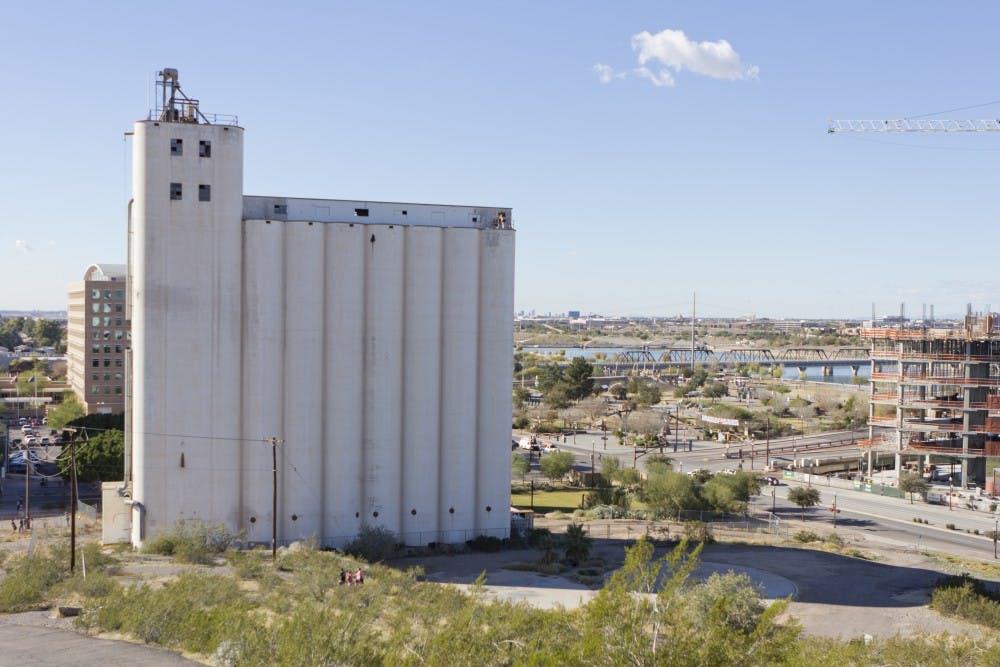 Hayden Flour Mill, as seen from Tempe Butte, or "A" Mountain, on Jan. 14, 2015. The Tempe City Council has finalized an agreement to renovate the iconic mill. (Emily Johnson/The State Press)
Hayden Flour Mill, as seen from Tempe Butte, or "A" Mountain, on Jan. 14, 2015. The Tempe City Council has finalized an agreement to renovate the iconic mill. (Emily Johnson/The State Press)The Tempe City Council finalized an agreement to negotiate the renovation of the iconic Hayden Flour Mill, but has not yet approved any blueprints or further plans.
In the agreement, the council decided to negotiate exclusively with Chicago-based Baum Development, to draft plans and decide on the future of the historical site, Tempe City Councilmember Kolby Granville said.
Most Tempe residents agree something must be done to the currently empty and fenced-off mill, but they share concern about preserving the history of the structure, which is nearly 150 years old.
“It’s a historic site and a significant site,” Granville said. “Whatever they choose to do, it must be done carefully.”
Granville said while Baum Development also submitted a blueprint of a plan for the site to the Council, that blueprint is not indicative of the city’s plans for the site. He said the Council expects to see an initial rendering of a plan within two to six weeks.
He stressed no designs have been submitted for actual discussion yet, and after the city receives the first draft, City Manager Andrew Ching and the City Council will discuss how to proceed.
“They are actively working on designs, which they will show the city manager,” Granville said. “If the city manager agrees, he will send it to the Council. The Council could say yes and the renovation could start quickly, or we could say no and modify it for months later.”
The agreement comes in a time of some big changes already happening in the Mill Avenue area, with the recent launch of the downtown Tempe rebranding effort, and the opening of new restaurants and stores in the area. However, Granville said negotiations have been taking place across two or three years, so the timing is purely coincidental.
This is not the first time companies have stepped forward and proposed to renovate the mill, but Granville said the Council approved the request this time because the real estate market is becoming more stable and recovering from recent economic problems.
Granville said a facelift for the mill could grow the economic potential of the downtown area, which is already popular for shopping and dining.
“Right now, the mill is the end of Mill Avenue,” he said. “We want people to continue walking all the way to the lake, which would extend the downtown area. The only way we could get people to continue walking is continuous storefronts for shoppers.”
Kate Borders, president and executive director of the Downtown Tempe Authority and leader of the rebranding effort, echoed Granville’s sentiments. She agreed an update to the mill would increase foot traffic and potential for new stores.
“This renovation will preserve the oldest building in Tempe and give it a new purpose,” Borders said in an email. “This nod to our past while ushering in the future is exactly what this space needed. But what is key to this development, and the Monti’s project across the street, is the connectivity to the Tempe Town Lake."
Borders also said downtown activity decreases greatly at the light rail on Third Street and there is less pedestrian movement north on Mill.
"These two iconic projects will visually stimulate the corridor and encourage people to continue on their journey, making the downtown and Tempe Town Lake one contiguous destination," she said.
Borders said while she and her team were not part of the negotiations for the mill, she is excited for what the changes will bring to the evolving downtown Tempe area and said the renovation will “truly transform the intersection of Mill and Rio Salado.”
No plans have been finalized for the mill yet, but residents can expect the integrity of the iconic structure to remain, Granville said.
“Whatever we build, I would like it to showcase the mill as the focal point of the street,” Granville said. “We want to be sensitive to the historic nature of the building and enhance it. The mill isn’t going anywhere.”
Reach the reporter at cvanek@asu.edu or follow @CorinaVanek on Twitter
Like The State Press on Facebook and follow @statepress on Twitter




